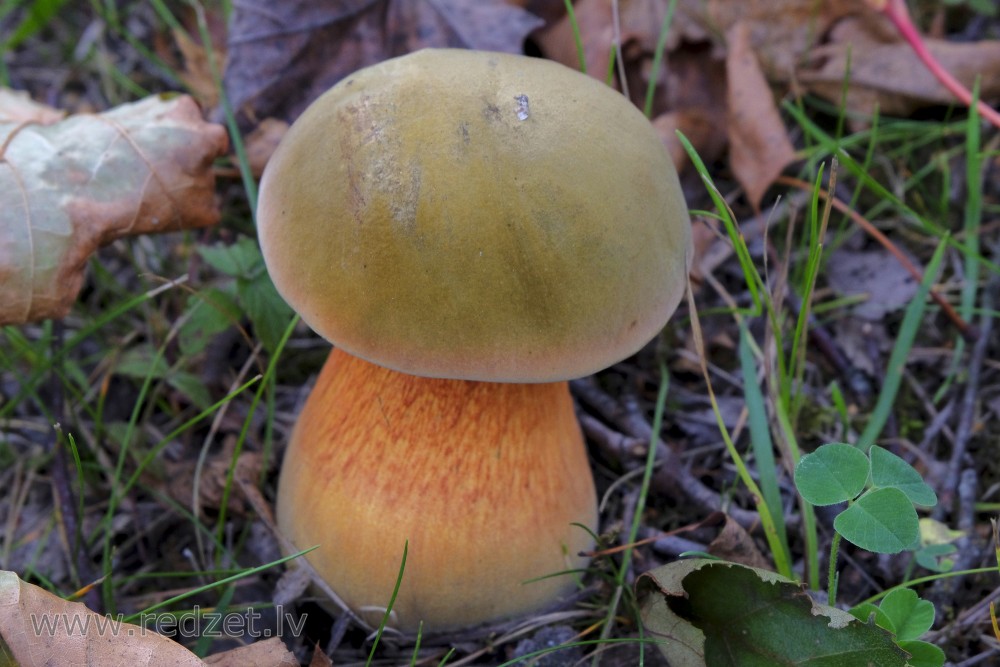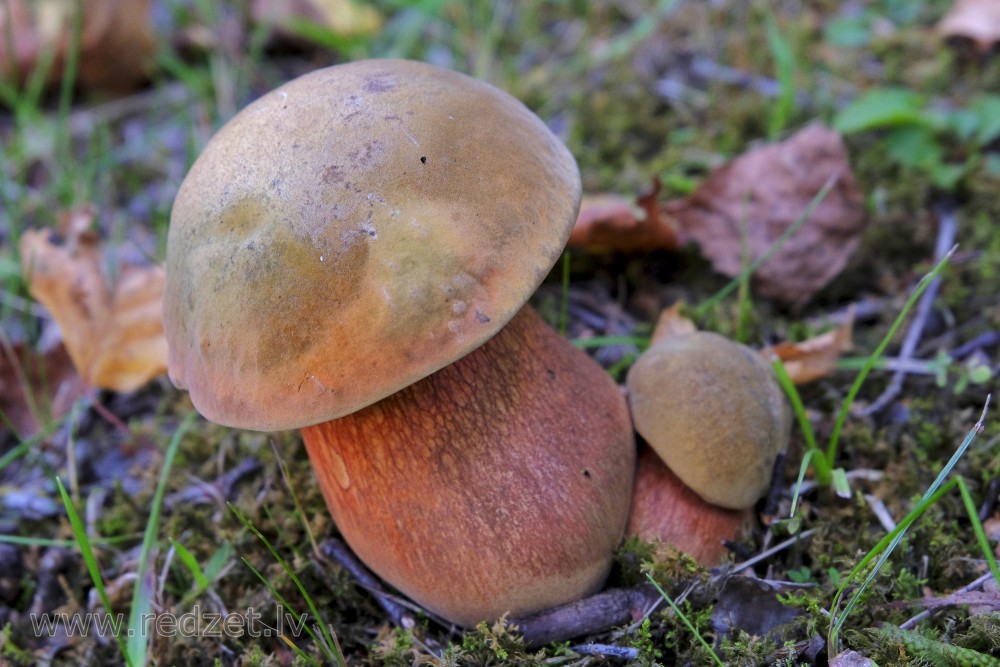Suillellus luridus (Lurid bolete)
Suillellus luridus (formerly Boletus luridus), commonly known as the lurid bolete, is a fungus of the bolete family, found in deciduous woodlands on chalky soils in Asia, Europe, and eastern North America. Fruit bodies appear in summer and autumn and may be abundant. It is a solid bolete with an olive-brown cap up to 20 cm (8 in) in diameter, with small red pores on the underside. The stout ochre stem reaches 8–14 cm (3–6 in) high and 1–3 cm (0.4–1.2 in) wide, and is patterned with a red mesh-work. Like several other red-pored boletes, it stains blue when bruised or cut. Though edible when cooked, it can cause gastric upset when eaten raw and can be confused with the poisonous Boletus satanas, though the latter species has a pale cap; as a result, some guidebooks recommend avoiding consumption altogether. When consumed with alcohol, Suillellus luridus has been implicated in causing adverse reactions similar to those caused by the compound coprine, though laboratory testing has not revealed any evidence of coprine in the mushroom.
First described in 1774, the species has been transferred to various Boletaceae genera in its taxonomic history, although it retained the original name given to it by German botanist Jacob Christian Schaeffer until a transfer to genus Suillellus in 2014. Several varieties, a subspecies, and a form have been described by European mycologists. Suillellus luridus is mycorrhizal, forming a symbiotic association with deciduous trees such as oak, birch and beech, and has been found to have a growth-enhancing effect on conifers in experiments. The fruit bodies are highly attractive to, and often infested by, insects, and several species of fly have been recorded feeding on them. Chemical analyses have revealed some aspects of the mushroom's components, including its volatile flavour compounds, its fatty acid and amino acid compositions, and the identities of the carotenoid compounds responsible for its colour.
Description
Suillellus luridus is a stout fungus with a thick yellow-olive to olive-brown convex cushion-shaped cap that can reach 20 cm (8 in) in diameter.The cap colour tends to darken with age, and regions of red, orange, purple, brown, or olive-green can develop in maturity. The cap surface is tomentose (velvety), becoming smoother with old age, and sticky in wet weather. The pore surface is initially dark red before turning orange-red, and has a lighter-coloured zone encircling the margin. There are 2–3 circular pores per millimetre, and the tubes are 1–2 cm (0.4–0.8 in) deep. The tubes are shorter around the cap margin and close to the stem, where they form a circular depression. Initially pale yellow, the tubes gradually become olive-yellow and then bluish-green upon exposure to air. A characteristic feature is the presence of a maroon layer between the tubes and the flesh. The thick stem is 8–14 cm (3–6 in) tall and 1–3 cm (0.4–1.2 in) wide, and bears a distinctive orange-red meshlike pattern on a paler yellowish or ochre background. The flesh is yellowish, with red marks in the cap, and stains an intense dark blue when bruised or broken. There is a faint sour smell, and the taste is described as mild.
Variety queletiformis can be distinguished from the main form by the reddish discolouration of the stem base that occurs both on the exterior surface and in the flesh. Variety rubriceps has a deep crimson red cap, while var. lupiniformis has a pale yellow or dirty ochre cap, sometimes with pink tones throughout.
The spore dust is olive to brownish olive. The spores are oval to somewhat fuse-shaped, measuring 11–15 μm long by 4.5–6.5 μm wide.The basidia (spore-bearing cells) are club-shaped and four-spored, and measure 29.2–36.5 by 11.0–12.4 μm. Cystidia on the sides of the tubes (pleurocystidia) are fuse-shaped with swollen middles and long necks, measuring 33–48 by 7.3–13.5 μm; cheilocystidia (on the edges of the pores) have a similar morphology. The cap cuticle is made of cylindrical hyphae 3.7–5.8 μm wide that are interwoven compactly, and the hyphal tips are erect and arranged in bundles. In contrast, the hyphae of the cap flesh is loosely interwoven with hyphae that are cylindrical and branched, measuring 3.7–8.8 μm. Hyphae do not contain clamp connections. The mycelium is an unusual yellow colour.
Some chemical tests can be used to help identify the mushroom. A drop of dilute potassium hydroxide placed on the cap cuticle will stain dark red to blackish, and orange-yellow on the flesh, while ferrous sulphate solution turns the cuticle yellow and then greenish-yellow. Melzer's reagent will turn the flesh dark blue, after the natural bluing reaction to injury has faded.
Toxicity
Mild tasting, Suillellus luridus is edible after thorough cooking and is highly regarded in France. It is also commonly consumed in Italy and China. The mushroom is sold in regional markets in central Mexico; despite this, it is considered inedible by inhabitants of La Malinche National Park. Caution is advised if choosing this species for consumption, as it resembles other less edible blue-staining boletes. Some guidebooks recommend avoiding it altogether. If eaten raw or insufficiently cooked, symptoms of gastrointestinal poisoning can occur within 30 minutes to two hours, including nausea, vomiting, abdominal cramps, and diarrhoea. A full recovery can be expected within 24 to 48 hours if fluid losses are restored. Chemical analysis has revealed traces of the toxin muscarine and its stereoisomers.
Suillellus luridus has been suspected of causing an enhanced alcohol sensitivity similar to that caused by the common ink cap (Coprinopsis atramentaria), with gastric symptoms. A German mycologist reported having suffered symptoms himself upon imbibing alcohol with this "otherwise excellent" mushroom. A 1982 report of three cases from Switzerland further incriminated the species, yet a 1994 study casts doubt on this; researchers Ulrich Kiwitt and Hartmut Laatsch looked for antabuse-like compound coprine content in S. luridus and similar species, and found none in the historical suspect but did find indications for it in the rare B. torosus. They concluded that the most likely explanation for historical incidents was a misidentification of B. torosus with S. luridus, though they could not rule out S. luridus containing a hitherto unidentified compound causing alcohol-related reactions.
en.wikipedia.org

